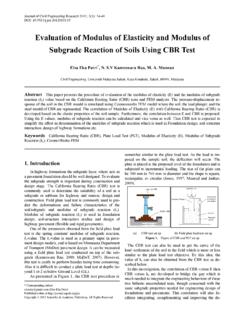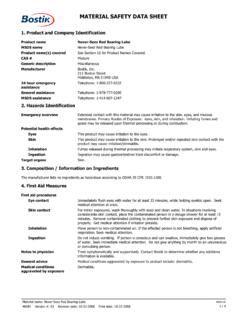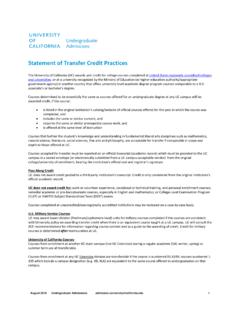Transcription of Stiffness, Strength, and Performance of Unbound …
1 DRAFTS tiffness, strength , and Performance of Unbound AggregateMaterial: Application of South African HVS and LaboratoryResults to california Flexible PavementsReport produced under the auspices of the california Partnered Pavement Research Programby:H L TheyseCSIR TransportekPO Box 395 Pretoria, Republic of South Africa0001 University of CaliforniaPavement Research CenterJuly 2002iiiiiTABLE OF CONTENTST able of Contents .. iiiList of Figures .. vList of Tables .. and South Africa Aggregate .. Specification .. of the Requirements .. Requirements .. Africa of the Requirements .. requirement .. of the california and South Africa Aggregate of Requirement .. Requirement .. Studies on Unbound Aggregate Base effective stiffness response of Unbound aggregate under HVS testing .. Deformation Response of Unbound Aggregate Under HVS Testing .. of an Unbound Aggregate Base and Drainable Subbase on an HVS TestSection .. Studies on Unbound Aggregate.
2 stiffness of Unbound Aggregate Under Laboratory Testing .. Shear strength Parameters of Unbound Deformation of Unbound Affecting the Stability of Unbound Aggregate Under Repeated Loading .. Modeling of the Plastic Deformation of Unbound Aggregate .. Potential of Unbound and 69 Appendix A .. 71 Pavement and Instrumentation Detail of HVS Test Sections .. 71vLIST OF FIGURESF igure 1. Comparison of the gradation envelopes for a 19-mm maximum size base layeraggregate from california and a maximum size base layer aggregatefrom South Africa.. 10 Figure 2a. Comparison of california samples with South Africa gradation control points for maximum particle size aggregate.. 12 Figure 2b. Comparison of california samples with dense aggregate gradation control points for a19-mm maximum particle size aggregate.. 12 Figure 3. Comparison of the gradation envelopes for Class 1 subbase aggregate ( california ) andG4 aggregate (South Africa).. 13 Figure 4.
3 Combined CBR data for the three aggregates from california showing the relationshipbetween compaction moisture content and CBR.. 15 Figure 5. CBR data for a G2 aggregate from South Africa showing the relationship betweencompaction level and CBR.. 15 Figure 6. The relationship between the bulk stress and effective stiffness modulus of naturalgravel and crushed stone aggregate.. 25 Figure 7. The effect of traffic loading and degree of saturation on the stiffness of the crushedstone aggregate from Road P157/2.. 26 Figure 8. The relationship between the effective stiffness and bulk stress of crushed stoneaggregate from a number of HVS 26 Figure 9. The effective stiffness modulus of crushed stone aggregate for theduration of HVS test 28 Figure 10. Illustration of typical base permanent deformation (rutting) behavior. Note: PD =permanent deformation (rut depth or permanent vertical strain).. 30viFigure 11. Bedding-in plastic strain, plastic strain rate, and bearing capacity results for a numberof crushed stone aggregate layers determined from HVS 31 Figure 12.
4 Gradation of the base and drainable subbase aggregate fromHVS Test Section 303a2.. 34 Figure 13. Permeability coefficient of the base and subbase aggregate from HVS Test Section303a2 as a function of relative density (modified AASHTO compaction).. 35 Figure 14. The observed and predicted values of the resilient modulus for acrushed stone aggregate..40 Figure 15. The relationship between the cohesion, relative density, and degree of saturation for acrushed stone aggregate..44 Figure 16. The relationship between the friction angle, relative density, and degree of saturationfor a crushed stone 44 Figure 17a. Friction angle versus relative density for crushed stone and natural gravel aggregate;component effect: compaction.. 47 Figure 17b. Friction angle versus saturation for crushed stone and natural gravel aggregate;component effect: 47 Figure 17c. Cohesion versus relative density for crushed stone and natural gravel aggregate;component effect: compaction.
5 48 Figure 17d. Cohesion versus saturation for crushed stone and natural gravel aggregate;component effect: 48 Figure 18a. Friction angle versus relative density for crushed stone aggregate;component effect: compaction.. 50viiFigure 18b. Friction angle versus saturation for crushed stone aggregate;component effect: 50 Figure 18c. Cohesion versus relative density for crushed stone aggregate;component effect: compaction.. 51 Figure 18d. Cohesion versus saturation for crushed stone aggregate;component effect: 51 Figure 19a. Friction angle and cohesion results plotted against relative density and degree ofsaturation for natural gravel aggregate; component effect: 52 Figure 19b. Friction angle and cohesion results plotted against relative density and degree ofsaturation for natural gravel aggregate; component effect: 52 Figure 20. Stable and unstable permanent deformation response ofdynamic traxial test samples.. 53 Figure 21. Effect of the degree of saturation on the stress ration level at which unstablepermanent deformation 56 Figure 22.
6 Equal values for the stress ratio generated at different values of absolute 58 Figure 23a. Stress ratio N data set for crushed stone aggregate, percentrelative density and percent 60 Figure 23b. Stress ratio N data set for crushed stone aggregate, percentrelative density and 78 percent 60 Figure 24a. Contour plot of the permanent deformation bearing capacity model for the unboundaggregate tested by Theyse, 86 percent relative density, 70 percent saturation.. 61 Figure 24b. Contour plot of the permanent deformation bearing capacity model for the unboundaggregate tested by Theyse, 86 percent relative density, 45 percent saturation.. 61viiiFigure 24c. Contour plot of the permanent deformation bearing capacity model for the unboundaggregate tested by Theyse, 88 percent relative density, 70 percent saturation.. 62 Figure 24d. Contour plot of the permanent deformation bearing capacity model for the unboundaggregate tested by Theyse, 88 percent relative density, 45 percent saturation.
7 62ixLIST OF TABLEST able 1 Gradation Specification for Base Layer Aggregate .. 5 Table 2 Gradation Specification for Subbase Layer 5 Table 3 Quality Requirements for Base Layer Aggregate .. 6 Table 4 Quality Requirements for Subbase Layer 6 Table 5 Gradation Requirements for Base Layer Aggregate .. 7 Table 6 Quality Requirement for Base Aggregate .. 8 Table 7 Quality Requirement for Subbase 9 Table 8 HVS Tests from which Data Was Utilized in This 21 Table 9 Back-calculated Effective stiffness Moduli from Maree et al.(8) .. 22 Table 10 Back-calculated Effective stiffness Moduli for Crushed Stone Aggregate .. 23 Table 11 Base Bedding-in Displacement, Deformation Rate, and Bearing Capacity Results for aNumber of Crushed Stone Aggregate Base Layers from HVS Test Sections .. 32 Table 12 Gradation, Density, and Moisture Content Properties of the Crushed Stone Aggregatefrom the Base and Drainable Subbase Layers from Section 34 Table 13 Permeability Coefficient of the Base and Subbase Aggregate from HVS Test Section303a2 as a Function of Relative Density (Modified AASHTO Compaction).
8 35 Table 14 Factors Affecting the Relationship between the Resilient Modulus and the Bulk StressCondition of Unbound 38 Table 15 Resilient Modulus Values for a Crushed Stone Aggregate at Different Combinationsof Density and 16 Factors Affecting the Relationship Between the Resilient Modulus and the Bulk StressCondition of Unbound 42 Table 17 Cohesion (kPa) results for crushed stone 43xTable 18 Friction Angle Results for the Crushed 43 Table 19 Shear strength Parameters of a Selection of Crushed Stone andNatural Gravel Aggregate .. 46 Table 20 Dynamic Triaxial Test Results from Maree (17) .. INTRODUCTIONC altrans specifies the use of a 75-mm Asphalt Treated Permeable Base (ATPB) layer asstandard practice for all new flexible pavement designs in california .(1) The ATPB acts as adrainage layer beneath the asphalt concrete (AC) and is supported by an aggregate base , the potential exists for water to enter the Unbound aggregate base layer from the ATPB layer through the prime coat that separates them.
9 The stiffness , strength , and Performance ofunbound aggregate layers are largely influenced by moisture assessment of the Performance of two types of flexible pavement cross section, onewith and one without an ATPB layer, were included in the strategic plan of the CAL/APTprogram (1994 2000). Goal 1 and Goal 5 of the CAL/APT project (continued in the PartneredPavement Research Program after 2000) consist of the evaluation of these two sections under dryand wet base conditions, evaluation includes accelerated pavement testing using the Heavy Vehicle Simulator(HVS) and laboratory testing. The test plan for Goal 5 (2) includes, the evaluation of the effectsof compaction and water content on the stiffness of the aggregate base and subbase layers. Thefirst objective of Goal 5 is to measure the effectiveness of the ATPB layer in the drainedpavement in preventing a decrease in stiffness and strength of the Unbound layers. Those resultsare included in References (3 6).
10 It is, however, not only the degree of saturation of an unboundaggregate that influences the Performance of the material but also the level of compaction of objective of this report is to illustrate the effect of the level of compaction and thedegree of saturation on the stiffness , strength , and plastic deformation of Unbound aggregatelayers based on information obtained from HVS and laboratory testing in South Africa. Theresults will permit extrapolation of Goal 1 and Goal 5 results to other california materials and2structures. The information presented in this report also contributes towards the improvedunderstanding and modeling of the behavior of Unbound aggregate material for mechanistic-empirical design scope of the information presented herein is limited to the aggregate used forpavement base and subbase layers. A comparison of california and South Africa specificationsfor base and subbase aggregate material is presented to identify possible similar materialcategories for which it is thought similar response and behavior will be tests that were performed on pavements with Unbound aggregate base layers wereidentified and the deflection and permanent deformation responses of these test sections wereextracted from the CSIR HVS database to be evaluated in terms of the objective of this from laboratory projects that were performed in association with the HVS program in SouthAfrica in addition to the HVS data are presented in order to facilitate a more detailed evaluationof the effect of density and degree of saturation on the stiffness , strength , and plastic deformationof Unbound aggregate california AND SOUTH AFRICA AGGREGATEThe california and South Africa materials classification systems distinguish betweendifferent aggregate classes or categories.






